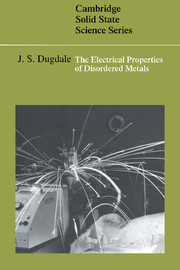Book contents
- Frontmatter
- Contents
- Preface
- 1 Context and content
- 2 Production and structure of metallic glasses
- 3 Electron transport in metals: introduction to conventional theory
- 4 Scattering
- 5 Simple liquid metals: Ziman theory
- 6 Phonons in disordered systems
- 7 Interactions and quasi-particles
- 8 Transition metals and alloys
- 9 The Hall coefficient of metallic glasses
- 10 Magnetoresistance
- 11 Electrical conductivity of metallic glasses: weak localisation
- 12 The interaction effect or Coulomb anomaly
- 13 The effect of the Coulomb interaction on conductivity
- 14 Influence of a magnetic field on the enhanced interaction effect
- 15 The thermopower of metals and alloys
- 16 Comparison with experiment
- Appendices
- Notes
- References
- Index
1 - Context and content
Published online by Cambridge University Press: 21 January 2010
- Frontmatter
- Contents
- Preface
- 1 Context and content
- 2 Production and structure of metallic glasses
- 3 Electron transport in metals: introduction to conventional theory
- 4 Scattering
- 5 Simple liquid metals: Ziman theory
- 6 Phonons in disordered systems
- 7 Interactions and quasi-particles
- 8 Transition metals and alloys
- 9 The Hall coefficient of metallic glasses
- 10 Magnetoresistance
- 11 Electrical conductivity of metallic glasses: weak localisation
- 12 The interaction effect or Coulomb anomaly
- 13 The effect of the Coulomb interaction on conductivity
- 14 Influence of a magnetic field on the enhanced interaction effect
- 15 The thermopower of metals and alloys
- 16 Comparison with experiment
- Appendices
- Notes
- References
- Index
Summary
Introduction
Ordered crystalline metals
Our understanding of the electrical conductivity of metals began almost a century ago with the work of Drude and Lorentz, soon after the discovery of the electron. They considered that the free electrons in the metal carried the electric current and treated them as a classical gas, using methods developed in the kinetic theory of gases.
A major difficulty of this treatment was that the heat capacity of these electrons did not appear in the experimental measurements. This difficulty was not cleared up until, in 1926, Pauli applied Fermi–Dirac statistics to the electron gas; this idea, developed by Sommerfeld and his associates, helped to resolve many problems of the classical treatment. The work of Bloch in 1928 showed how a fully quantal treatment of electron propagation in an ordered structure could explain convincingly many features of the temperature dependence of electrical resistance in metals. In particular it showed that a pure, crystalline metal at absolute zero should show negligible resistance.
From these beginnings followed the ideas of the Fermi surface, band gaps, Brillouin zones, umklapp processes and the development of scattering theories: the scattering of electrons by phonons, impurities, defects and so on. By the time of the Second World War, calculations of the resistivity of the alkali metals showed that the theory was moving from qualitative to quantitative success.
In 1950, the recognition that the de Haas–van Alphen effect provided a measure of the extremal cross-section of the Fermi surface normal to the applied magnetic field made possible a big advance in the experimental study of Fermi surfaces.
- Type
- Chapter
- Information
- The Electrical Properties of Disordered Metals , pp. 1 - 5Publisher: Cambridge University PressPrint publication year: 1995



